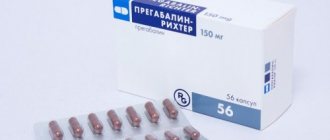Antiepileptic drugs are medications used for epilepsy to prevent or treat epileptic seizures. In addition, these drugs are used to prevent or treat seizures that occur due to other diseases. Therefore, they are also called anticonvulsants.
Epilepsy is a common chronic disease of the nervous system, which usually manifests itself as repeated seizures - convulsions. Epileptic seizures are generalized (spread to both hemispheres of the brain) and partial (occur in a strictly defined area of the brain).
The development of seizures is preceded by an aura - nausea, weakness, dizziness, speech impairment, numbness of the lips, tongue, loss of consciousness. Next, convulsions occur directly: tonic (the body and limbs are stretched in a state of tension, the jaws are clenched, and breathing is held) and clonic (contraction of the muscles of the limbs, neck, and torso).
Sometimes convulsions are manifested by individual muscle twitching without loss of consciousness (myoclonus), sudden short-term freezing, lack of reaction (absence).
Epilepsy usually occurs in childhood and most often the cause cannot be determined. Heredity, intrauterine oxygen deprivation of the fetus during pregnancy, and birth injuries play a certain role in the development of epilepsy.
Seizures can also be a symptom of other diseases or conditions that occur at any age. Thus, seizures can occur with head injuries, hemorrhage in the brain, intracranial tumors, pregnancy, oxygen starvation, metabolic disorders, overdose of substances that affect the nervous system (including alcohol).
Indications for use
All antiepileptic drugs are used to treat epilepsy, as well as symptomatic seizures in other diseases of the nervous system.
Certain drugs (carbamazepine, gabapentin, pregabalin) are also used to treat neuralgia and neurogenic pain (associated with nerve damage).
Lamotrigine, carbamazepine, oxcarbazepine, and valproic acid are additionally used to normalize mood in patients with bipolar affective disorder, which is characterized by alternating periods of manic agitation and depression.
pharmachologic effect
Convulsions occur when the balance between excitation and inhibition in the brain is disturbed in the direction of excitation. Mediators (signal transmitters between neurons) are responsible for this balance:
- inhibitory – gamma-aminobutyric acid (GABA), glycine;
- stimulating – amino acids glutamate, aspartate.
In addition, sodium and calcium channels of neurons play a huge role in the generalization (spread) of excitation. Antiepileptic drugs affect one or more mechanisms maintaining the balance of excitation and inhibition in the brain.
anticonvulsants
Anticonvulsants, mechanism of influence on the processes of inhibition and excitation in the central nervous system: suppression of convulsive reactions and decreased muscle tone: hexamidine, trimethine, features of use.
An anticonvulsant effect can be exerted by various substances that weaken the progress of excitation or enhance the processes of inhibition in the central nervous system, including barbiturates, bromides, tranquilizers of various groups, etc. However, a number of drugs stand out for their specific anticonvulsant activity and effectiveness in pathological conditions accompanied by convulsive reactions (intoxication , infectious diseases, central nervous system injuries, etc.).
Of particular importance are anticonvulsants that are effective in epilepsy and are used to prevent or relieve seizures or their corresponding equivalents (loss or impairment of consciousness, behavioral and autonomic disorders, etc.) in certain forms of this disease. Anticonvulsant (antiepileptic) drugs include synthetic compounds of different chemical groups: barbituric acid derivatives (phenobarbital, benzonal, benzobamyl, hexamidine); derivatives of hydantoin (diphenin), oxazolidinedione (trimethine), succinimides (ethosuximide, pufemide), iminostilbene derivatives (carbamazepine), etc. Relatively recently, benzodiazepine drugs have been developed that have a particularly pronounced anticonvulsant effect (clonazepam, etc.). A fundamentally new group of antiepileptic drugs has appeared: valproic acid and its salts (acediprole or convulex, etc.). Depending on the chemical structure and pharmacological properties, various anticonvulsant (antiepileptic) drugs exhibit preferential activity in different forms of epilepsy. Thus, for grand mal seizures, phenobarbital and diphenine are used primarily; Hexamidine, carbamazepine, and valproic acid are also effective. For psychomotor equivalents, carbamazepine, diphenin, hexamidine, clonazepam are used mainly, and for minor attacks (petit mal) trimethim, succinimides, benzodiazepines, valproic acid. Diazepam (Sibazon) is administered intravenously for status epilepticus. Various anticonvulsants are also used for convulsive reactions of a non-epileptic nature.
As a rule, anticonvulsants do not have strict specificity for different forms of epilepsy. The same drug can be effective to varying degrees for different manifestations of epilepsy. At the same time, there is no drug with a universal type of action that is sufficiently effective for all forms and manifestations of epilepsy. Therefore, different antiepileptic drugs are often prescribed simultaneously in various combinations, and, if necessary, one drug is replaced by another.
Antiepileptic drugs are used to prevent or reduce (in intensity and frequency) seizures or their corresponding equivalents (loss or impairment of consciousness, behavioral and autonomic disorders, etc.), observed periodically occurring attacks of various forms of epilepsy. The mechanism of action of the drugs is not entirely clear, because In most cases, the etiology of epilepsy is unknown. They note the possibility of a decrease in the excitability of neurons in the epileptic focus under the influence of these drugs. Recently, much attention has been paid to studying the role of neurotransmitters in the pathogenesis of epilepsy. It is believed that neuronal hypersensitivity and instability of membrane potentials, leading to spontaneous discharges, may be caused by an increase in the concentration of central stimulating neurotransmitters or a decrease in the content of inhibitory neurotransmitters. In this regard, the role of these mediators in the mechanism of action of antiepileptic drugs is being studied. Special attention is paid to γ-aminobutyric acid (GABA), which is the main inhibitory transmitter in the central nervous system. The role of another inhibitory amino acid mediator glycine and the excitatory amino acid mediators glutamate and aspartate are also being studied.
Apparently, one possibility is to reduce the excitability of neurons in the epiletogenic focus. However, there is more evidence that in the main group of antiepileptic drugs their inhibitory effect on the spread of pathological impulses predominates.
Primary reactions underlying the antiepileptic action of substances occur at the level of neuronal membranes. There is evidence that some antiepileptic drugs block Na channels (diphenine, carbamazepine), while others activate the GABA system (phenobarbital, benzodiazenins, sodium valproate). In addition, it has been shown that blocking T-type calcium channels (for example, in the thalamus) is also one of the mechanisms for reducing seizure activity. It is possible that trimethine, ethosuxemide and, partially, sodium valproate act according to this principle. As anticonvulsants, it is of interest to block different subtypes of glutamate receptors, as well as substances that reduce the release of glutamate from presynaptic terminals. Experiments have proven that under the influence of antiepileptic drugs there is an increase in the refractory period, a decrease in lability, some trace reactions and, in general, inhibition of interneural transmission of excitation and limitation of the spread of impulses generated by the epiletogenic focus.
Inhibition of interneuronal transmission of excitation by antiepileptic substances can be associated both with inhibition of neuronal excitation processes and with increased inhibitory effects, including stimulation of inhibitory neurons. Antiepileptic drugs are usually used continuously and for a long time, so it is necessary to carefully monitor their tolerability, take into account their characteristic toxic properties, and be careful in dosing, taking into account pharmacokinetic parameters.
The main types of side effects of these drugs are allergic, toxic and metabolic reactions. Allergic reactions, expressed not only in the form of skin and other usual manifestations, but also in the form of increased seizures, deterioration of mental state, etc., require immediate discontinuation of the drug used and its replacement with a drug of another group. Toxic reactions (psychopathological and neurological syndromes, leukopenia and other hematological disorders) are more often observed with prolonged uncontrolled use of the drug. In such cases, a gradual dose reduction and appropriate detoxification therapy are necessary. Metabolic disorders (endocrine disorders, megaloblastic anemia, etc.) require immediate discontinuation of the drug used and replacement with another. Particularly careful monitoring is necessary with the combined use of antiepileptic drugs, primarily in patients with residual effects of previous organic brain diseases.
The replacement of one antiepileptic drug with another should be done gradually, reducing the dose of the previously used drug and replacing it with a new drug in increasing doses. To avoid embarrassment of seizures, it is necessary to ensure that between drugs prescribed again and previously used, dose ratios that are equivalent in strength are maintained. These ratios are different for different drugs. For example, the equivalent ratios of doses of some drugs to doses of phenobarbital (taken as 1) for diphenine are approximately 1.4: 1; for hexamidine 3:1; for benzonal 2:1; for chloracone 15:1. The withdrawal of antiepileptic drugs in all cases should be done gradually (to avoid the development of seizures up to status epilepticus).
It must be taken into account that antiepileptic drugs can penetrate the placental barrier and have a teratogenic effect. Foreign literature describes cases of developmental anomalies in newborns whose mothers took sodium valproate, as well as carbamazepine in combination with sodium valproate, diphenine or phenobarbital. In some cases, when using antiepileptic drugs (phenobarbital, diphenine, hexamidine, valproates, etc.), a deficiency of folic acid develops, which requires replenishment of this vitamin. However, large doses of folic acid can weaken the anticonvulsant effect of these drugs and contribute to an increase in epileptic seizures. There have been cases of vitamin K deficiency with bleeding in newborns whose mothers took phenobarbital, hexamidine, and diphenine. If necessary, vitamin K preparations should be prescribed prophylactically to pregnant women taking antiepileptic drugs (under the control of the blood coagulation system).
TRIMETINE
(Trimethinum). 3, 5, 5-Trimethyloxazolidinedione-2, 4
Synonyms: Absentol, Edion, Epidione, Petidion, Ptimal, Trepal, Tridione, Trimedal, Trimethadionum, Troxidon.
White crystalline powder with a weak, peculiar odor and a cooling, bitter taste. Soluble in water, easily soluble in alcohol,
Trimethine is an anticonvulsant, used mainly for minor forms of epilepsy, as well as for mental and vascular-vegetative equivalents.
The drug is quickly absorbed. Peak plasma concentrations are observed 1/2 to 2 hours after administration. Slowly excreted from the body. The half-life in blood plasma is 12 - 24 hours.
Metabolized (demethylated) in the liver to form an active metabolite (demethadione), which is slowly excreted by the kidneys. With prolonged use, the drug can accumulate in the body.
Trimethine is prescribed orally (during or after meals): adults usually 0.20-3 g, 2-3 times a day, children 0.05-0.10 - 1.50-2 g, 2-3 times in a day. Treatment is carried out in courses of 3-5 months. During breaks, phenobarbital is prescribed.
Higher doses for adults: single dose 0.4 g, daily dose 1.2 g.
Trimethine, like a number of other antiepileptic drugs, has an analgesic effect in trigeminal neuralgia, but acts more slowly than carbamazepine. It is recommended to prescribe trimethin for trigeminal neuralgia in the following doses: in the first week 0.2 g 4 times a day, in the second 0.2 g 3 times a day, in the third 0.2 g 2 times a day, in the fourth week 0.2 g 1 time per day. This dose is usually prescribed in the future as a maintenance dose. When treated with trimethine, side effects may occur: photophobia, hemeralopia, skin rash, exfoliative dermatitis, changes in blood count (neutropenia, agranulocytosis, anemia, eosinophilia, monocytosis). During treatment, blood tests should be performed at least every 10 days.
The use of trimethine can provoke the development of major attacks of epilepsy, so it is recommended to prescribe phenobarbital or other antiepileptic drugs simultaneously. There is information about the possibility of a teratogenic effect of the drug. Due to side effects and the emergence of new, more effective drugs, trimethin currently has limited use.
Trimethine is contraindicated in cases of liver and kidney dysfunction, diseases of the hematopoietic organs and optic nerve.
Release form: powder. Storage: List B. In a well-closed container.
HEXAMIDINE
(Hexamidinum). 5-Ethyl-5-phenylhexahydropyrimidinedione-4, 6.
Synonyms: Primidone, Desoxyphenobarbitone, Lepimidin, Lespiral, Liskantin, Mizodin, Mylepsin, Mysoline, Prilepsin, Primaсlone, Primidonum, Primidone, Primoline, Prysoline, Sedilen, Sertan, etc.
White crystalline powder. Practically insoluble in water, slightly soluble in alcohol.
Its chemical structure is a deoxybarbiturate; It differs from phenobarbital in that in position 2 the carbonyl group (C==O) is replaced by a methylene group (CH2). This chemical modification of the molecule resulted in a drug with strong anticonvulsant effects and less hypnotic effects.
When taken orally, hexamidine is rapidly and almost completely absorbed. Peak plasma concentrations are observed after approximately 3 hours. The half-life in plasma is 7-14 hours. The drug is metabolized to form phenobarbital (about 20%) and another active metabolite, phenylethylmalonamide. About 40% of the unchanged drug is excreted in the urine.
Hexamidine is used mainly for grand mal seizures. Less effective for mild abortive seizures and mental equivalents. In minor forms of epilepsy it does not have a permanent effect, but in some cases a therapeutic effect is observed.
Take orally after meals. The initial daily dose for adults is 0.125 g (in 1-2 doses), then the dose is gradually increased to 0.5-1 g per day. Higher doses for adults: single 0.75 g, daily 2 g. Children, depending on age, are prescribed from 0.125 to 0.5 g per day.
In the first days of treatment with hexamidine, mild drowsiness, dizziness, headache, ataxia, and nausea are possible. These phenomena usually go away on their own. If necessary, the dose is gradually reduced or the drug is discontinued, and after a few days a reduced dose is prescribed. Long-term use of hexamidine in large doses can lead to the development of adverse nervous and mental disorders, hematological complications (leukopenia, lymphocytosis, anemia). Hexamidine enhances the effect of hypnotics, sulfonylurea derivatives, cyclophosphamide, and methotrexate. By increasing the activity of microsomal liver enzymes, it accelerates the biotransformation of coumarin derivatives, estrogenic contraceptives, griseofulvin, and doxycycline.
When prescribing hexamidine to pregnant and breastfeeding women, it should be taken into account that its action is similar to phenobarbital. With long-term use of hexamidine, a deficiency of folic acid in the body may develop. The drug is contraindicated in cases of dysfunction of the liver, kidneys, or hematopoietic system. Release form: tablets of 0.125 and 0.25 g in a package of 50 pieces. Storage: list B. In a well-closed container.
10
Classification of antiepileptic drugs
There are several classifications of antiepileptic drugs: according to the characteristics of use in different forms of epilepsy - types of paroxysms, according to the mechanism of action, as well as the chemical structure of the drugs.
According to the mechanism of action, the following groups of antiepileptic drugs are distinguished:
Sodium channel blockers
- Hydantoin derivatives (phenytoin)
- Carboxamide derivatives (carbamazepine, oxcarbazepine, eslicarbazepine acetate)
- Others (lamotrigine, lacosamide)
Calcium channel blockers
- Succinimide derivatives (ethosuximide)
- Others (pregabalin)
Agents that enhance the inhibitory effects of GABA
- Barbiturates (phenobarbital, benzobarbital)
- Benzodiazepines (diazepam, clonazepam, lorazepam)
- Others (vigabatrin, gabapentin, tiagabine)
Agents that inhibit the action of excitatory amino acids
- Felbamate
Combination agents
- Fatty acid derivatives (valproic acid and its salts - valproates)
- Others (topiramate)
According to the characteristics of their use in different forms of epilepsy, antiepileptic drugs are divided into:
- Drugs used for partial seizures: valproate, carbamazepine, lamotrigine, vigabatrin, gabapentin, phenobarbital, clonazepam, phenytoin.
- Drugs used for generalized seizures:
- for grand mal seizures - valproate, carbamazepine, phenobarbital, phenytoin, lamotrigine;
- for small convulsive seizures (absences) - ethosuximide, valproate.
In addition to the drugs listed in the classification, seizures can be eliminated or prevented by magnesium preparations (magnesium sulfate) when administered intravenously, anesthetics (sodium hydroxybutyrate, sodium thiopental).
Anticonvulsants: classification and mechanisms of action
According to the modern definition of the International League Against Epilepsy and the International Bureau of Epilepsy in 2005 (ILAE, IBE, 2005), “epilepsy is a disorder (disease) of the brain characterized by a persistent predisposition to the generation (development) of epileptic seizures, as well as neurobiological, cognitive, psychological and social consequences of this condition.” Epilepsy is one of the most common diseases of the nervous system. Worldwide, the prevalence of epilepsy is 4–10/1000 people, corresponding to 0.5–1.0% of the population. [1]
The International Classification of Epileptic Seizures distinguishes two main types: generalized and partial. Generalized seizures include tonic-clonic, tonic, clonic, myoclonic seizures and absence seizures; to partial - simple, complex and secondary generalized. However, the wide variety of seizures does not always allow them to be classified as one of these types of seizures, so another category has been highlighted - “unclassified” seizures, which include 9–15% of seizures. [2] Currently, to differentiate attacks, they use the classification adopted in 1981 in Kyoto, Japan. The ability to correctly differentiate seizures is a necessary component of rational selection of anticonvulsant therapy.
The classification of forms of epilepsy is very extensive, but globally all epilepsy can be divided according to etiology into:
1. Idiopathic (genetic (hereditary) predisposition in the absence of other possible causes of the disease); [3]
2. Symptomatic (the cause of the disease is brain damage due to various factors acting during pregnancy and after childbirth: brain malformations (mainly malformations of the cerebral cortex - cortical dysplasia); intrauterine infections; chromosomal syndromes; hereditary metabolic diseases; hypoxic-ischemic brain damage in the perinatal period (during childbirth, in the last weeks of pregnancy, in the first week of a child’s life); infectious diseases of the nervous system (meningitis, meningoencephalitis); traumatic brain injury; tumors, degenerative diseases of the nervous system); [3]
3. Cryptogenic (epileptic syndromes, the etiology of which is unknown or unclear. The word “cryptogenic” itself is translated as secret, hidden. These syndromes do not yet meet the requirements of the idiopathic variety, but they cannot be classified as symptomatic epilepsy).
The mechanism of action of anticonvulsants (anticonvulsants) is not fully understood. This is largely due to insufficient knowledge of epilepsy as such, since often the cause of convulsive attacks cannot be determined. An imbalance between inhibitory (GABA, glycine) and excitatory neurotransmitters (glutamate, aspartate) is important in the development of epileptogenic activity of the brain. For excitatory amino acids, there are specific receptors in the brain - NMDA and AMPA receptors, associated in neurons with fast sodium channels. It has been established that the glutamate content in brain tissue in the area of the epileptogenic focus is increased. At the same time, the content of GABA in the brain tissues of patients with epilepsy is reduced. [4]
Antiepileptic drugs are classified, usually based on their use in certain forms of epilepsy: [4]
I. Generalized forms of epilepsy - Grand mal seizures (grand mal; tonic-clonic seizures): Sodium valproate. Lamotrigine, Diphenine, Topiramate, Carbamazepine, Phenobarbital, Hexamidine. — Status epilepticus: Diazepam, Clonazepam, Diphenin-sodium, Lorazepam, Phenobarbital-sodium, Anesthesia. - Petit mal; absense epilepsia: Ethosuximide, Clonazepam, Trimethine, Sodium valproate, Lamotrigine. — Myoclonus-epilepsy: Clonazepam, Sodium valproate, Lamotrigine.
II. Focal (partial) forms of epilepsy Carbamazepine, Lamotrigine, Clonazepam, Tiagabine, Sodium valproate, Phenobarbital, Topiramate, Vigabatrin, Difenin, Hexamidine, Gabapentin.
There is also a classification by “generations” of drugs: I - 1st generation anticonvulsants Phenobarbital, Phenytoin, Carbamazepine, Valproic acid, Ethosuximide. II - 2nd generation anticonvulsants Felbamate, Gabapentin, Lamotrigine, Topiramate, Tiagabine, Oxcarbazepine, Levetiracetam, Zonisamide, Clobazam, Vigabatrin. III - 3rd generation anticonvulsants (newest, many in the clinical trial stage) Brivaracetam, Valrocemide, Ganaxolone, Karabersat, Carisbamate, Lacosamide, Losigamon, Pregabalin, Remacemide, Retigabine, Rufinamide, Safinamide, Seletracetam, Soretolide, Stiripentol, Talampanel, Fluorofelbamate, Fosphenytoin, Eslicarbazepine, DP-valproic acid. This post will discuss the main drugs of the 1st and 2nd generations.
In addition, antiepileptic drugs can be classified based on the principles of their action:
Figure 1. | Sites of action of various drugs on GABA metabolism
I. Sodium channel blockers: Diphenine, Lamotrigine, Topiramate, Carbamazepine, Sodium valproate.
II. T-type calcium channel blockers: Ethosuximide, Trimethine, Sodium valproate.
III. Agents that activate the GABAergic system: 1. Agents that increase the affinity of GABA to GABA-A receptors Benzodiazepines, Phenobarbital, Diazepam, Lorazepam, Clonazepam, Topiramate. 2. Agents that promote the formation of GABA and prevent its inactivation Sodium valproate 3. Agents that prevent the inactivation of GABA Vigabatrin 4. Agents that block neuronal and glial uptake of GABA Tiagabine
IV. Drugs that reduce the activity of the glutamatergic system: 1. Drugs that reduce the release of glutamate from presynaptic terminals Lamotrigine 2. Drugs that block glutamate (AMPA) receptors Topiramate
Sodium channel blockers
Carbamazepine (Tegretol, Finlepsin) is an iminostilbene derivative. The anticonvulsant effect of the drug is due to the fact that it blocks sodium channels in the membranes of nerve cells and reduces the ability of neurons to support high-frequency impulses, typical of epileptogenic activity; blocks presynaptic sodium channels and prevents transmitter release. The drug is metabolized in the liver, increases the rate of its own metabolism due to the induction of microsomal liver enzymes. One of the metabolites, carbamazepine-10,11-epoxide, has anticonvulsant, antidepressant and antineuralgic activity. Excreted mainly by the kidneys (more than 70%). Side effects: loss of appetite, nausea, headache, drowsiness, ataxia; violation of accommodation; diplopia, heart rhythm disturbances, hyponatremia, hypocalcemia, hepatitis, allergic reactions, leukopenia, thrombocytopenia, agranulocytosis (blood picture monitoring is required). There is a risk of developing teratogenic effects. Carbamazepine increases the metabolic rate, as a result of which it reduces the concentration of certain drugs in the blood, including antiepileptic drugs (clonazepam, lamotrigine, sodium valproate, ethosuximide, etc.).
Phenytoin (Difenin) is a derivative of hydantoin. Anticonvulsant effect: blockade of sodium channels; reducing the entry of sodium ions into neurons; disruption of the generation and propagation of high-frequency discharges; decreased excitability of neurons, preventing their activation when impulses arrive from an epileptogenic focus. To prevent seizures, phenytoin is prescribed orally in tablet form. Phenytoin sodium is used to relieve status epilepticus and is administered intravenously. Phenytoin intensively binds to plasma proteins (90%). Metabolized in the liver, the main inactive metabolite, 5-(p-hydroxyphenyl)-5-phenylhydantoin, is conjugated with glucuronic acid. It is mainly excreted from the body by the kidneys in the form of metabolites. Side effects: dizziness, agitation, nausea, vomiting, tremor, nystagmus, ataxia, diplopia, hirsutism; gingival hyperplasia (especially in young people), decreased folate levels and megaloblastic anemia, osteomalacia (associated with impaired vitamin D metabolism), allergic reactions, etc. Teratogenic effects have been noted. Causes the induction of microsomal enzymes in the liver and thus accelerates the metabolism of a number of drugs (corticosteroids, estrogens, theophylline), increases their concentration in the blood.
Lamotrigine (Lamictal) blocks sodium channels in neuronal membranes and also reduces the release of glutamate from presynaptic terminals (which is associated with blockade of sodium channels in presynaptic membranes). Side effects: drowsiness, diplopia, headache, ataxia, tremor, nausea, skin rashes. [5]
T-type calcium channel blockers
Ethosuximide (Suxilep) belongs to the chemical class of succinimides, which are derivatives of succinic acid. Anticonvulsant effect: blocks T-type calcium channels involved in the development of epileptic activity in the thalamocortical region. It is the drug of choice for the treatment of absence seizures. Metabolized in the liver. It is mainly excreted from the body by the kidneys in the form of metabolites and about 20% of the administered dose is unchanged. Side effects: nausea, vomiting, dyskinesia; headache, drowsiness, sleep disturbances, decreased mental activity, anxiety, allergic reactions; rarely - leukopenia, agranulocytosis.
The mechanism of action of some antiepileptic drugs includes several components and it is not established which of them is predominant, as a result of which these drugs are difficult to classify into one of the above groups. Such drugs include valproic acid and topiramate.
Valproic acid (Acediprol, Apilepsin, Depakine) is also used in the form of sodium valproate. Anticonvulsant effect: 1) blocks sodium channels of neurons and reduces the excitability of neurons in the epileptogenic focus; 2) inhibits the enzyme that metabolizes GABA (GABA transaminase) + increases the activity of the enzyme that is involved in the synthesis of GABA (glutamate decarboxylase); increases the content of GABA in brain tissue; 3) blocks calcium channels. It is excreted mainly by the kidneys in the form of conjugates with glucuronic acid or as oxidation products. Side effects: nausea, vomiting, diarrhea, stomach pain, ataxia, tremor, allergic skin reactions, diplopia, nystagmus, anemia, thrombocytopenia, impaired blood clotting, drowsiness. The drug is contraindicated in cases of impaired liver and pancreas function.
Topiramate (Topamax) has a complex, not fully understood mechanism of action. It blocks sodium channels and also increases the action of GABA on GABA-A receptors. Reduces the activity of excitatory amino acid receptors (presumably kainate). The drug is used for adjunctive treatment of partial and generalized tonic-clonic seizures in combination with other antiepileptic drugs. Side effects: drowsiness, lethargy, decreased appetite (anorexia), diplopia, ataxia, tremor, nausea. [5]
Drugs that increase GABAergic activity
Phenobarbital (Luminal) interacts with specific binding sites (barbiturate receptors) located on the GABA-A receptor complex and, causing allosteric regulation of the GABA-A receptor, increases its sensitivity to GABA. At the same time, the opening of chlorine channels associated with the GABA-A receptor increases - more chlorine ions enter the cell through the neuron membrane and hyperpolarization of the membrane develops, which leads to a decrease in the excitability of neurons in the epileptogenic focus. In addition, it is believed that phenobarbital, interacting with the neuron membrane, causes a change in its permeability for other ions (sodium, potassium, calcium), and also exhibits antagonism towards glutamate. Metabolized in the liver; the inactive metabolite (4-hydroxyphenobarbital) is excreted by the kidneys in the form of a glucuronide, about 25% unchanged. Side effects: hypotension, allergic reactions (skin rash), feeling of weakness, drowsiness, depression, ataxia, nausea, vomiting. Phenobarbital causes a pronounced induction of microsomal liver enzymes and therefore accelerates the metabolism of drugs, including the acceleration of the metabolism of phenobarbital itself. With repeated use it causes the development of tolerance and drug dependence.
Benzodiazepines (Clonazepam) stimulate benzodiazepine receptors of the GABA-A receptor complex; The sensitivity of GABA-A receptors to GABA increases and the frequency of opening of chlorine channels increases, the entry of more negatively charged chlorine ions into the cell is stimulated, resulting in hyperpolarization of the neuronal membrane and increased inhibitory effects of GABA. Side effects: fatigue, dizziness, loss of coordination, muscle weakness, depression, disturbances in thinking and behavior, allergic reactions (skin rash). With long-term use in children, clonazepam can cause impairment of mental and physical development. When administered parenterally, respiratory depression (up to apnea), hypotension, and bradycardia are possible. Vigabatrin (Sabril) is a structural analogue of GABA and irreversibly inhibits GABA transaminase, which breaks down GABA. Increases GABA content in the brain. Vigabatrin has a wide spectrum of anticonvulsant action, is used to prevent grand mal seizures, and is effective for partial seizures.
Gabapentin (Neurontin) was created as a lipophilic structural analogue of GABA to stimulate GABAA receptors in the brain. However, it does not have GABA-mimetic activity, but has an anticonvulsant effect. The mechanism of action is not clear; it is assumed that the drug promotes the release of GABA; the possibility of blocking the transport systems of excitatory amino acids cannot be ruled out. Gabapentin is used as an adjunct in the treatment of partial seizures. The drug is effective for neuropathic pain. Side effects: drowsiness, dizziness, ataxia, tremor, headache. [5]
Sources:
- Alekseev V.V., Yakhno N.N. Main syndromes of damage to the nervous system // Diseases of the nervous system. Ed. NN Yakhno, DR Shtulman. Moscow - 2001
- Zatsepilova T. A., Alyautdin R. N. Pharmacology. — 2004.
- Kharkevich D. A. Pharmacology: Textbook – 10th ed., revised, revised. and additional //M.: GEOTAR-Media, 2010. - 752 p. — 2010.
- Epilepsy // Fact sheet N°999. WHO October 2012
- https://vk.cc/70bi6o
Epilepsy Treatment Basics
Antiepileptic drugs are prescribed only by a specialized specialist - a neurologist or psychiatrist - after a complete neurological examination of the patient. In this case, the type of epileptic seizures must be taken into account.
Antiepileptic drugs are usually prescribed after the second attack. The earlier treatment begins, the better and easier it is to control seizures.
Therapy is usually started with one drug (monotherapy). The effectiveness of treatment is assessed over 3 months. Ideally, the drug completely prevents seizures. In case of ineffectiveness, the drug is changed or a combination of two (less often three) drugs is used.
Epilepsy drugs
Epileptic seizures occur when potassium leaves nerve cells at the same time calcium and sodium enter it. An impulse failure occurs, which provokes the release of neurotransmitters. Some activate the attack (glutamate), others inhibit it (GABA). Antiepileptic drugs are necessary in order to properly influence neurotransmitters and normalize the functioning of neurons.
AEDs are classified into different groups based on their mechanism of action:
- sodium and calcium blockers;
- glutamate blockers;
- GABA receptor stimulants;
- multiple action drugs.
There are also the following groups of drugs against epileptic seizures:
- anticonvulsants (anticonvulsants);
- sedatives (calming);
- vitamin complexes.
All medicines are produced in the form of tablets (capsules, granules), syrup (drops), powders for solution, injections. Each form of drugs has different bioavailability (rate of absorption into the blood):
- Solid (tablets, capsules). They can be slow or immediate. The former are used more often due to the absence of a sharp increase in the concentration of the active substance, which leads to its rapid decrease and reduction of the effect - this is how immediate-release tablets work. The delayed type is preferable due to the long-lasting effect, which allows you to minimize the number of medications taken.
- Soluble. The granules can be dissolved in water or yogurt - this method of consumption is well suited for small children or people with swallowing disorders.
- Liquid (drops, syrups). They are considered the most convenient for treating children and the elderly due to ease of use. Usually the packaging contains measuring devices (spoon, syringe).
- Injections. Indispensable in urgent situations due to its high bioavailability, when it is necessary to quickly relieve an acute attack. Most often used in hospitals or by emergency doctors.
Anticonvulsants
Anticonvulsants help prevent, reduce, or completely eliminate an epileptic seizure. Anticonvulsants block the excitation of nerve cells and activate GABA receptors, which inhibit excitation. Today doctors prescribe medications based on the following active ingredients:
- Sodium valproate. Increases the amount of GABA and stimulates its activity.
- Ethosuximide. Blocks calcium and sodium channels, weakens the effect of glutamate.
- Carbamazepine, phenytoin. Reduce the number of neurons in sodium channels, reduce the effects of amino acids and glutamate.
- Phenobarbital, primidone. Accelerate the activity of GABA receptors in calcium channels.
- Lamotrigine, oxcarbazepine, oxcarbazepine. They reduce the excitation of sodium neurons and inhibit glutamate activity.
- Levetiracetam, topiramate. They have multiple effects on nerve cells and neurotransmitters.
- Tiagabine. Blocks the attack of GABA by neurons, increases the concentration of beneficial neurotransmitters.
- Gabapentin. In addition to activating calming receptors, it relieves pain and tension.
Sedatives
Epileptics are often prescribed sedatives and sleeping pills - the active substances in tablets and injections help relieve stress, calm the nervous system and weaken the effect of impulses that provoke seizures. Usually prescribed:
- Valerian. Relaxes muscles, normalizes heart rate, suppresses attacks.
- Afobazol. It has a gentle effect on the nervous system and improves sleep.
- Relanium. Relieves anxiety, fears, overexcitement.
- Tenoten. Relieves psycho-emotional stress without atrophying muscles.
- Antidepressants. Prevents stress, panic and depression, which often cause seizures.
Other drugs
- Painkillers. An epileptic attack may be accompanied by pain in the head and muscles. Analgesics eliminate pain and additionally have an anti-inflammatory, vasodilating and calming effect.
- Hormonal. Most hormones in excess provoke an attack, but some of them (for example, dexamethasone) stop the transmission of impulses.
- Nootropic. They promote normal brain function while suppressing the activity of neurotransmitters.
Some doctors prescribe dietary supplements as a form of prevention and additional stimulation of the positive effect of drugs. It is not recommended to choose biological additives on your own - despite their plant origin, certain components can be harmful.
Vitamins and minerals for epilepsy
Vitamin and mineral complexes are especially necessary for young children or people following a ketogenic diet. With epilepsy, the patient has limited nutrition, which negatively affects physical and mental development. What vitamins and minerals restore the body’s functioning:
- B vitamins: For healthy metabolism and energy, the body needs folic acid, B6 and B12 - they eliminate drug resistance.
- Vitamin D. In epileptics, the liver actively produces enzymes that flush vitamin D from the body. Calcium deficiency threatens osteoporosis.
- Antioxidants. Taking medications reduces the amount of selenium, vitamins C and E, so the use of antioxidants is included in the medication course.
- Magnesium. Necessary for maintaining the balance of neurotransmitters, as well as for the inhibition of calcium channels.
- Melatonin. Inhibits excitatory receptors and glutamate, helps restore sleep and the biological rhythm of life, gives strength and energy.
- Omega-3. Fatty acids are essential for epilepsy due to their anticonvulsant effect. Large amounts of fat in the blood stimulate the production of ketones, which replace the stimulating glucose but are not harmful.
Features of epilepsy treatment
Epilepsy is a chronic disease that requires long-term, often lifelong, treatment. If epilepsy is not treated, the patient experiences behavioral disturbances, emotional disorders, and memory loss (epileptic dementia).
During treatment, patients are recommended to adhere to a normal sleep and rest schedule, a special diet high in fat and low in proteins and carbohydrates (ketogenic diet), and exclude alcohol, coffee, energy drinks and tobacco products from the diet.









